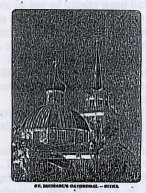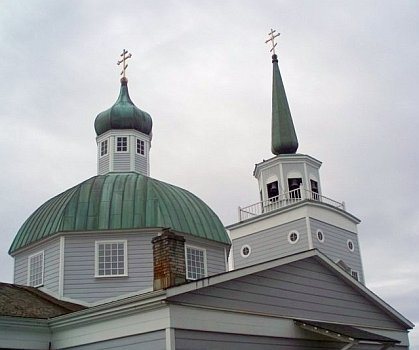|
Sitka: St. Michael's Cathedral
Old historic pictures are uncanny in the way they show St. Michaels almost unchanging, as the buildings on what is now Lincoln Street have gone from wooden fire traps, standing on a muddy dirt road, to modern buildings. The rest of the town aged, and has been replaced, but the cathedral remains unmoved throughout the decades. Pictures over a hundred years old show it looking almost the same as it does today, even though it was burnt to the ground in 1966—122 years after they first started building it. It was rebuilt, and they did a great job restoring its original appearance! They wouldn’t allow us to take pictures inside. So, we are left with fading memories of the interior of the building. The description in the brochure below can give you an idea of what was there. My general impression was that it was decorative, the paintings were good, and the golden doors were striking. The flow of the foot traffic moved around the outside of the room, in order to see the art. Speaking of art, as relates to the Orthodox Church, the term Orthodox originally was used to designate those who accepted church art (Icons), as opposed to the "Iconoclasts" who believed that church art—all art really—broke the commandment against "graven images," and so they set about destroying countless pieces of fine art during the period they held the Emperor's favor. No, even those who sat on the Imperial throne were not immune to this and many other of theological clashes that seemed to flow through Constantinople like breezes off the Sea of Marmara. In fact the Emperor often would be at the heart of the struggle going on! One side of the clash would come to be declared "orthodox" and the other side "heretical." And so another piece of Orthodox doctrine would be set firmly in place. (At least usually. Sometimes "heresies" didn't die so easy, and reared their heads repeatedly.) St. Michael's Cathedral was laid out as most Christian cathedrals are: in the general shape of a cross, with the entrance at the foot of the cross. There was a lot of open space, because there were no pews, since the congregation stands throughout their services. Even with its vaulted roof, and the fact that the building had a dominating position outside, marking the center of town as it does, inside I still had the feeling of a small country church, build in the general shape of a cathedral. When I visited the Cathedral of Valencia, in Valencia, Spain, I was simply awed by the incredible size of the place. I have to admit that I was happy to avoid having to look at the mummified arm of St Martin, which had been on display in Spain, however St. Michael's looked as if it could have stood in the foyer of the Spanish cathedral, and hardly blocked foot traffic. I enjoyed the Notre Dame Basilica, in Montreal, Quebec, Canada, far more than even the Cathedral of Valencia. It also was huge, but it was filled with pews and the most excellent art. It had the finest stained glass windows that I have ever seen, and had "small" side chapels that would have held St. Michael's with no difficulty. The gigantic exquisitely carved front doors were all by themselves sufficient to have made the trip to Montreal worth the effort. That cathedral was absolutely magnificent! But having said that, St. Michael's still held the warmth of a small church; and any one who has attended a small country church knows that it has something that a huge city church lacks. The warmth and pleasant friendship of a group of people getting together who all know each other, and fairly well, is hard to match in any large organization. There follows the text, and one graphic, from a brochure that I was handed in St. Michael's Cathedral. It describes the interior and gives a little history of the church as viewed through Orthodox eyes. ST. MICHAEL'S RUSSIAN ORTHODOX CATHEDRAL 
SITKA, ALASKA St. Michael's Russian Orthodox Cathedral (Orthodox meaning "True Faith") was built on this spot beginning in 1844 and was completed in 1848. Bishop Innocent Venlaminov, the first Orthodox bishop to reside in Alaska designed St. Michael's. Bishop Innocent was canonized a Saint in Russia in 1977 for his evangelization of the native people of Alaska and Siberia. He had many talents; he was an architect, carpenter, ethnographer, linguist and clockmaker, to name a few. He built the original clock in the cathedral. He also interpreted the Tlinget and Aleut languages, using the Russian Cyrillic to form an alphabet, thus giving them a written language. Eventually Bishop Innocent became Metropolitan of the Orthodox Church in Russia. Bishop innocent hired skilled Finnish carpenters to build the Cathedral. It was made of spruce logs and the ceilings and walls lined with sail cloth for insulation and acoustics. On January 2nd 1966 a fire began across the street in a dry goods store and eventually spread to the cathedral. Before the fire spread to St. Michael's the people of Sitka began removing the contents. By the time it was engulfed in flames over 100 people had formed human chains in and out of the front and side doors; handing items out of the doors. They saved 95% of the contents. The last item removed was the large chandelier hanging in the center under the dome. A local parishioner stacked benches to the bottom of the chain and lifted it down to two people who took it out of the cathedral. Later it took 6 people to carry it to storage. The chandelier weighs over 300 pounds. St. Michael's Cathedral, the Lutheran Church and over 22 businesses were destroyed by the fire. The present Cathedral is built of concrete and steel, and the ceilings and walls are lined with a fire-retardant canvas. It is a replica of the original and was completed in 1976. The cathedral is built in the shape of a cross. There are three altars. The side extensions are separate chapels. On the right is the chapel dedicated to St. Innocent and on left is the chapel dedicated to the Virgin Mary; the Sitka Madonna Chapel. There are no pews. In Alaska the faithful stand in reverence to God. Chairs and benches are for the elderly, guests and those who physically cannot stand. The bench in the center of the Cathedral is called a Cathedra or Bishop's Throne. Bishop Innocent made the Cathedra and placed it in the Cathedral to indicate that this is the "see" of the Diocese. The paintings inside the Cathedral are called icons (icon means image). We do not worship icons. We consider them to be our "Windows into the Kingdom of Heaven", and are given places of honor inside the "House of God", the Church. The wall across the front of the Cathedral is an Iconostasis or Icon Screen. The Sanctuary where the Altar is kept is behind the Iconostasis. This is the fulfillment of the Old Testament "Holy of Holies". The gold doors are called the Royal Doors, which symbolize the gates into the kingdom of Heaven. These gold doors are the original hand-carved wooden doors and were saved from the fire. A local' man, using a crowbar took them off the hinges and carried them out by himself. The Icons on the main iconostasis were brought to Sitka in 1813 aboard the Russian warship the "Neva". The Neva grounded and sank off Cape Edgecombe about 20 miles from Sitka. The icons were salvaged from the ship. The icon of St. Michael the Archangel on the far right of the Iconostasis was not with the salvage. Exactly 30 days after the sinking of the "Neva" a crate washed ashore in Sitka containing this icon. It was undamaged by sea water. The most highly revered icon in the Cathedral is the icon of the "Sitka Madonna" on the left of the Royal Doors in the Sitka Madonna Chapel. This icon is considered to be a wonderworking icon. Many miracles are attributed to intercessory prayers before "Our Lady of Sitka" or the "Sitka Madonna". Particularly miracles of the healing of eyes. It is an original copy of "Our Lady of Kazan" a very special wonderworking icon from Russia. "Our Lady of Sitka" is the work of the famous painter In Russia, Vladimir Borivikovsky, who died in 1825. This icon and the icon of "Christ the Teacher" on the right of the Royal Doors were given to St. Michael's by the laborers of the Russian American Company who saved their money in order to give these icons as a gift to the Cathedral. Candles are light to symbolize Christ as the "Light of the World". St. Michael's Cathedral is an active church with regular liturgical services, being held weekly and throughout the year. There are 55 active members and 95% of the membership are Native to Alaska, mainly those whose heritage is Tlinget. The services are held In English with many hymns and responses, sung in Slavonic, Tlinget, Aleut and Yupik Eskimo and Greek. Thank you for visiting St. Michael's Cathedral. It has been our pleasure to share this beautiful "Treasure" of the Orthodox Church in Alaska.
U
The Right Reverend UNIKOLAI
Bishop of Sitka, Anchorage & Alaska
(handwritten at the bottom)
Rev. Fr. Elia Larson Priest of the Archangel Michael Cathedral Donations may be sent to P.O. Box 697 Sitka, AK 99835 |

